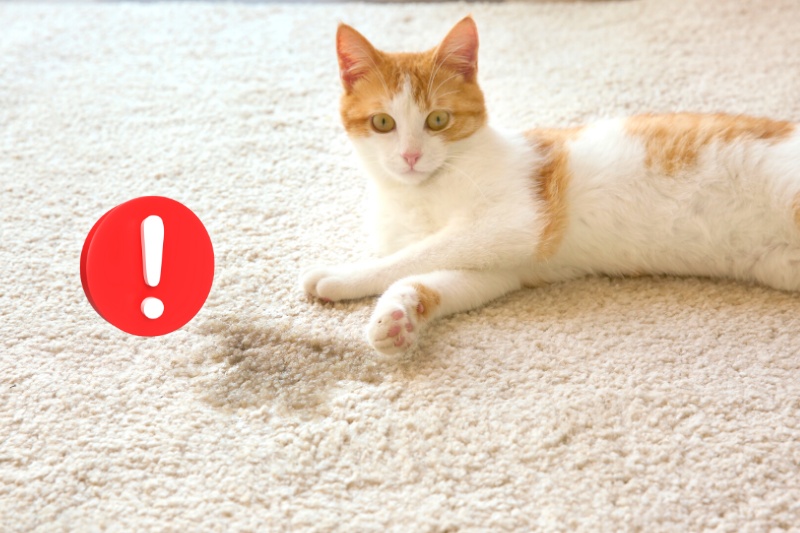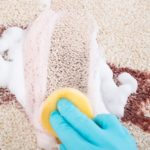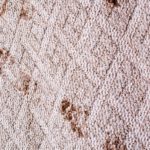Dealing with cat pee on a carpet is an unpleasant experience for any cat owner. Whether it’s a one-time accident or a recurring issue, it’s essential to address the problem promptly to prevent lingering odours and potential long-term damage to your carpet.
Fortunately, with effective carpet cleaning techniques, you can successfully remove cat pee from your carpet and restore its freshness.
In this article, we’ll provide you with a comprehensive guide on how to clean cat pee off a carpet and combat those unpleasant urine stains and odours for good!
How Do You Get Cat Pee Out of a Carpet?
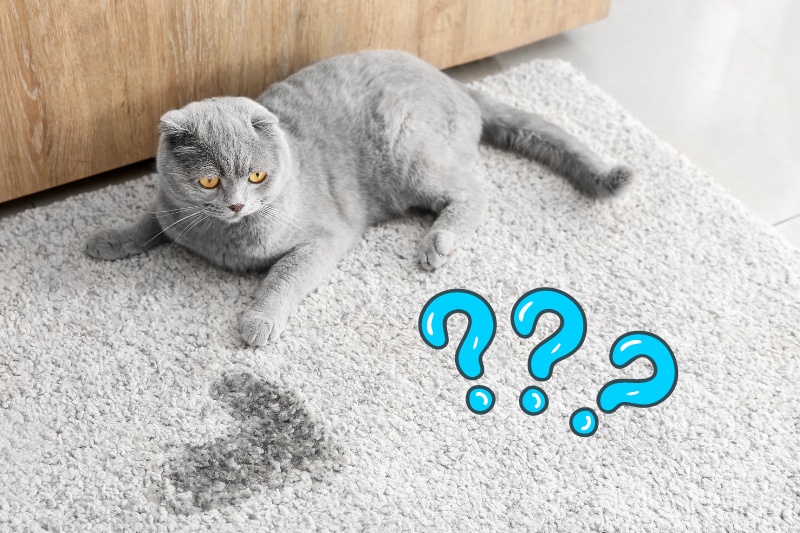
Cat urine contains ammonia, uric acid, and bacteria, which can create a strong odour and cause discolouration or damage to the carpet fibres if not addressed promptly.
Additionally, if the urine seeps into the padding or subfloor, it can be more challenging to eliminate the odour completely.
And even worse—cats have a strong sense of smell and are likely to pee in the same place repeatedly if the urine smell is not entirely eliminated.
This is frustrating and unpleasant and results in worse odours, harder-to-clean stains, and a seemingly never-ending problem.
Knowing how to clean cat pee from your carpet is therefore a must-know for all cat owners. Even the most well-behaved kitties are sure to have an accident occasionally, and proper cleaning can prevent this issue from continuously arising. And fortunately, we have a fool-proof guide on cleaning urine from carpets below:
Step 1: Blot and absorb
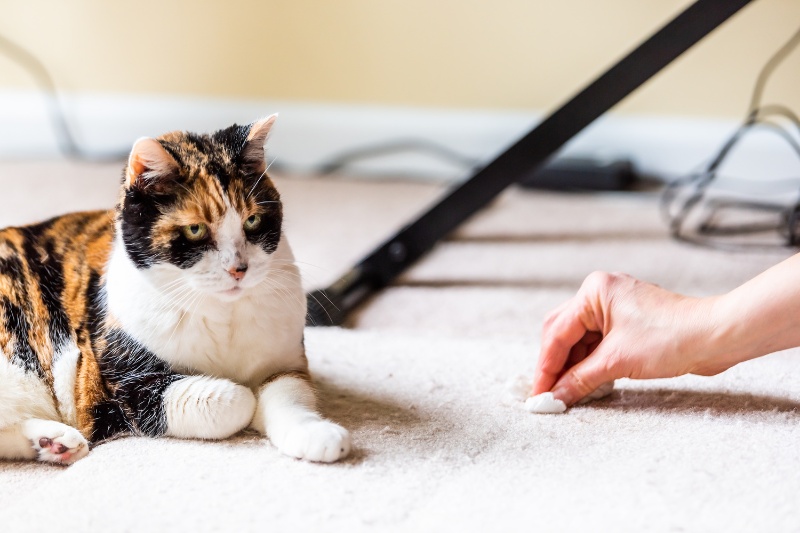
As soon as you discover cat pee on your carpet, the first step is to act quickly to minimise damage.
This helps to limit the spread of urine and prevents it from seeping into the carpet padding and the flooring beneath, making cleaning much more manageable.
Begin by blotting the urine with absorbent materials such as paper towels, old towels, or disposable cloths.
Apply gentle pressure to absorb as much urine as possible and push onto the puddle of pee using firm downward pressure.
Avoid rubbing or scrubbing, as this can spread the stain and embed it further into the carpet fibres.
Step 2: Choose a cleaning solution for cat pee
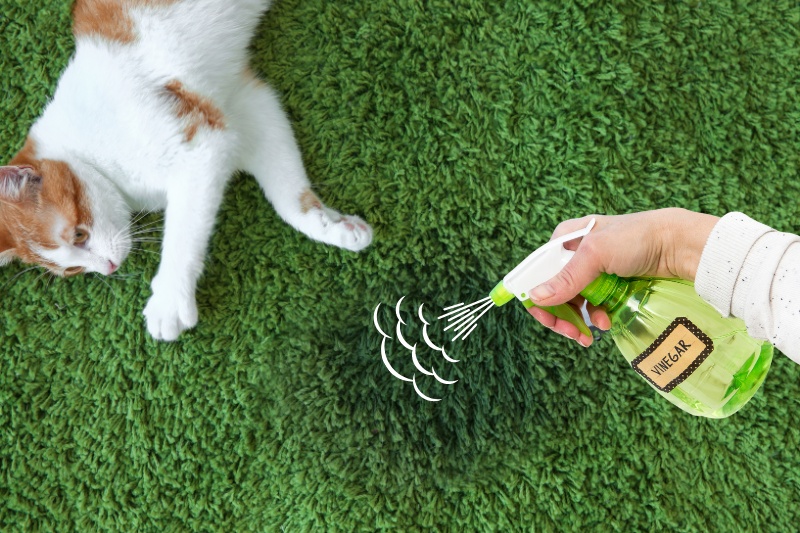
Once you have blotted the urine, you need to prepare a cleaning solution to break down the remaining stain and odour.
Several cleaning solutions can effectively combat cat urine stains and odours. Here are three popular and highly effective options:
- Vinegar & water solution: Vinegar is safe for use on carpets and is an effective cleaner, known for its natural deodorising properties that can help neutralise the smell of cat urine. To make this cleaner, mix equal parts of white vinegar and water in a spray bottle.
- Bicarbonate of soda & hydrogen peroxide: Bicarbonate of soda is an excellent odour absorber, while hydrogen peroxide acts as a stain remover. Using these two common household ingredients together can effectively cut through urine stains and smells—it’s a winning combination.
- Enzymatic cleaners: Enzymatic cleaners are specifically designed to break down and eliminate organic stains such as cat urine. They contain enzymes that target the uric acid crystals, effectively removing both the stain and nasty pee smell.
Step 3: Apply your cleaning product
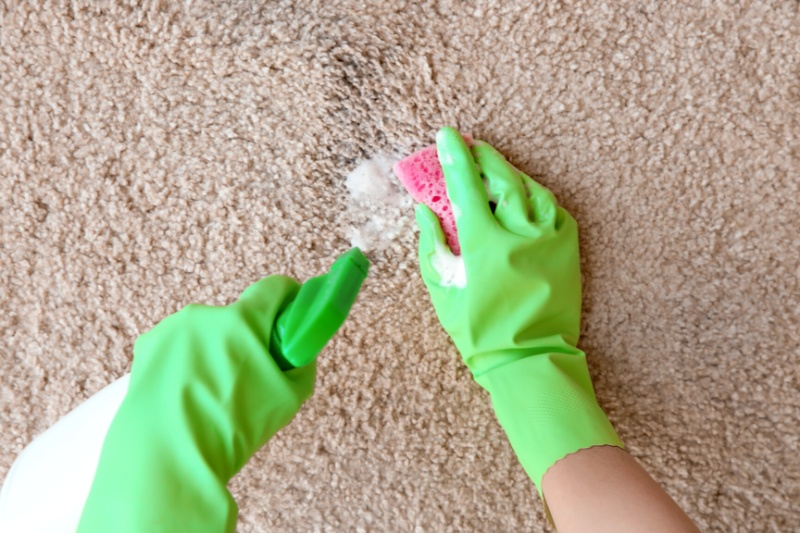
With your cleaner to hand, it’s time to apply it to the stain. However, the best method for this depends on your selected cleaning product.
Enzymatic cleaners should always be applied as per the guidelines on the bottle. Although there is some variation, this typically involves spraying the cleaner directly onto the stain, gently working the solution into the carpet with a sponge, waiting for 5 to 10 minutes, and then blotting away any excess.
You can use your white vinegar and water solution using the same application method: Spray, massage, wait, and blot.
However, if using bicarbonate of soda and hydrogen peroxide, the application method is slightly different:
- Mix one cup of hydrogen peroxide and one teaspoon of washing up liquid in a spray bottle.
- Sprinkle bicarbonate of soda over the stain, then spray the hydrogen peroxide mixture over the top. Apply generously, but avoid oversaturating the carpet.
- Gently work the mixture into the carpet using a sponge or your fingers, and let it sit for 15 to 20 minutes to work more deeply into the cat pee stain.
- Afterwards, blot up the excess liquid and vacuum the area once it’s dry to remove any remaining bicarbonate of soda powder.
You can reapply your chosen cleaner as many times as necessary, or switch to an alternative cleaner if you aren’t satisfied with the results.
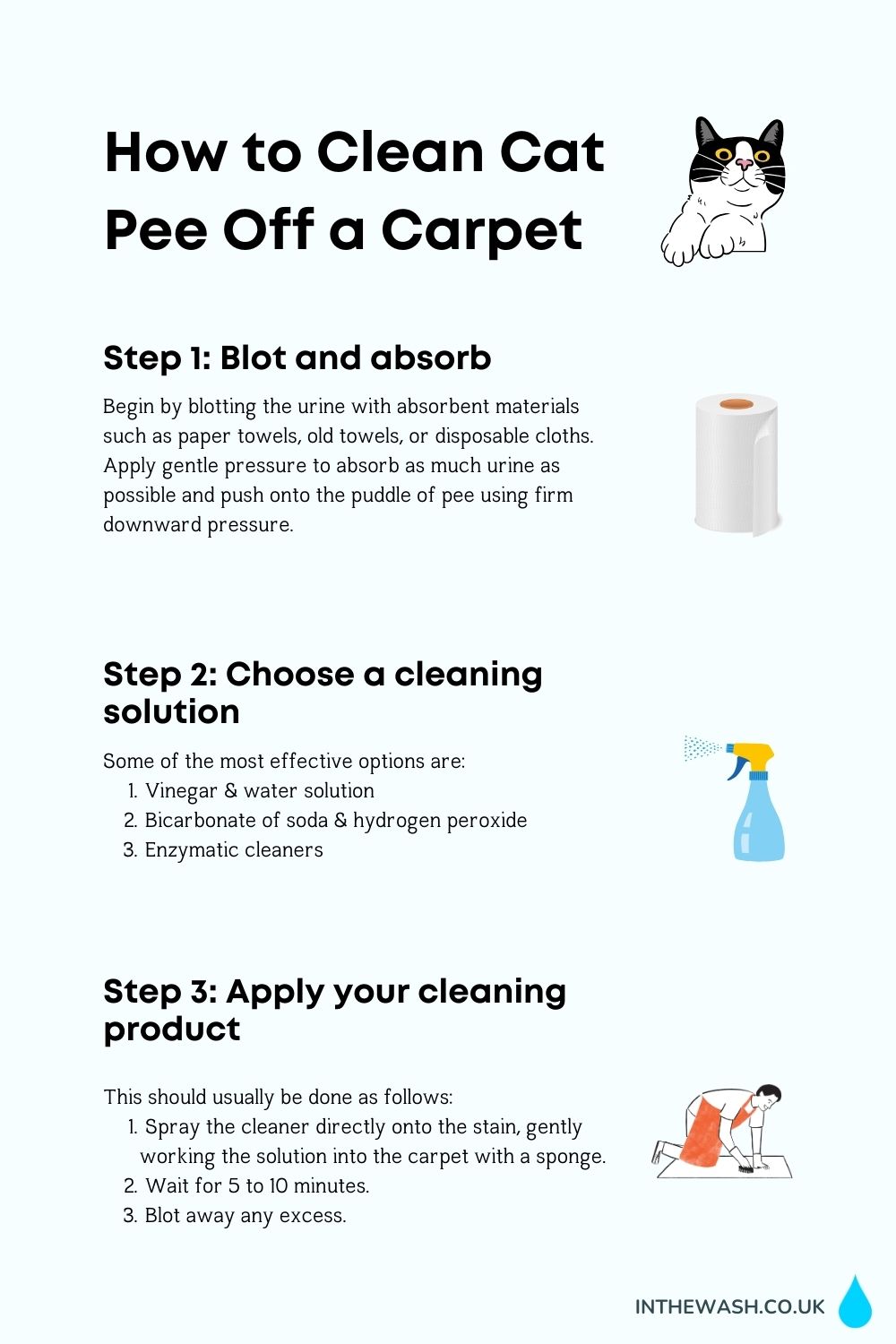
Application Techniques & Tips for Cleaning Cat Pee from Carpet
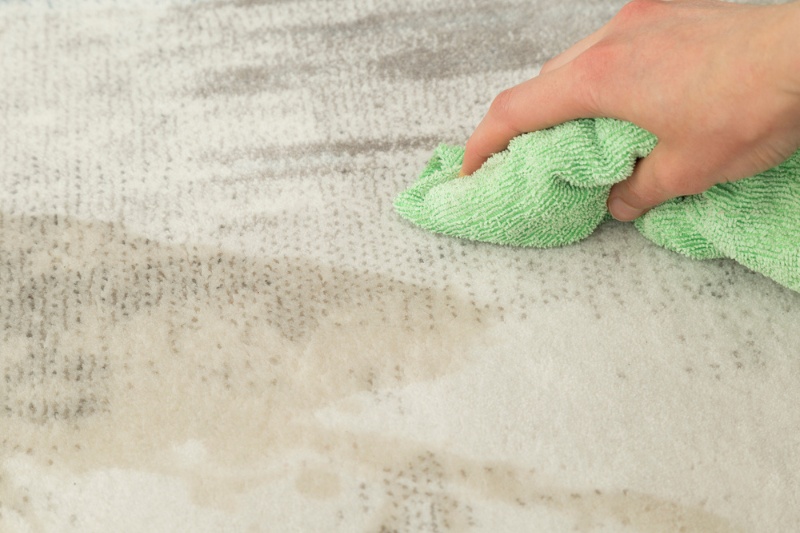
The cleaning techniques for cat pee on carpets vary depending not only on the type of cleaner you’re using, but also on the severity of the stain and the duration it has been present.
Spot cleaning may be sufficient for fresh accidents, while older or more extensive stains may require deep cleaning methods.
Below you can find helpful advice on both types of cleaning practises. This should help you remove cat pee marks and odours, regardless of whether you’re dealing with old or new pee stains.
How to spot clean cat pee from carpets
Spot cleaning involves focusing on the immediate area affected by cat urine. After blotting the urine, apply your chosen cleaning solution to the stain.
Use a clean cloth or sponge to gently work the solution into the carpet fibres and leave it for around 10 minutes.
Blot the area with a dry cloth to remove excess moisture, and repeat the process if necessary.
Avoid excessive moisture when applying the cleaner to your flooring.
More cleaner isn’t always better! In fact, using an excessive amount can damage the carpet fibre or cause the urine to spread. It could seep deeper into the padding and make the unpleasant smell harder to eliminate.
How to deep clean cat urine from carpets
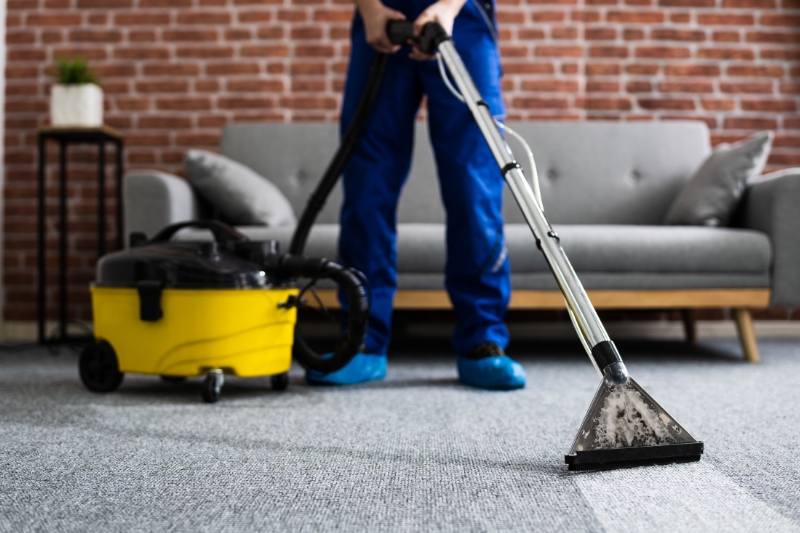
Deep cleaning is recommended for older or more severe cat urine stains that have penetrated the carpet fibres and reached the padding.
You can rent or buy a carpet cleaner or hire professional carpet cleaning services for this task.
If renting your own carpet cleaner, make sure to follow the instructions provided and use an appropriate cleaning solution.
After thoroughly cleaning the affected area, you must also extract as much moisture as possible to prevent mould or mildew growth.
If the problem persists despite your best efforts, it might be time to seek professional carpet cleaning services.
Tips for Cleaning Cat Pee from Carpets
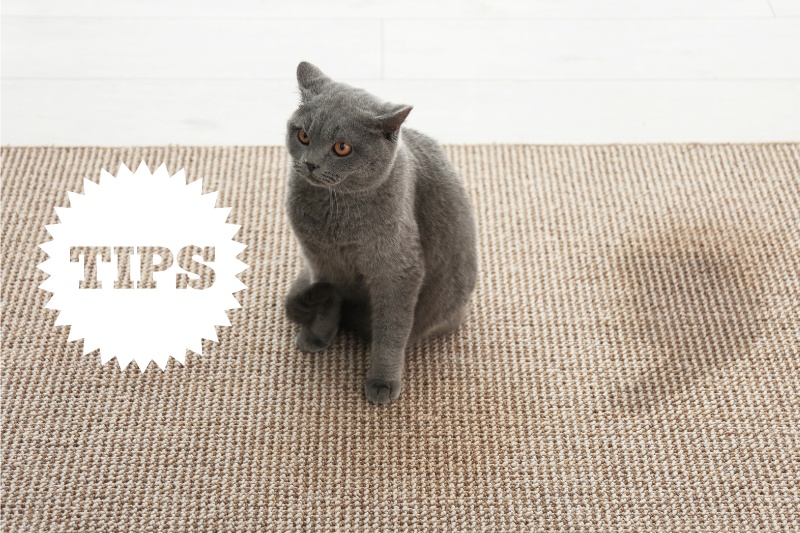
Below is a list of the must-know carpet cleaning hacks you can use when cleaning cat pee from your carpet. Follow these to ensure you get the best results possible:
- Patch test – Always do a patch test before applying cleaning products to ensure no damage occurs. Not all carpets can handle harsh cleaning chemicals, especially commercial enzymatic cleaners.
- Act quickly – Treat the urine stains as quickly as possible to prevent the cat pee from spreading into the deeper layers of your carpet and floorboards.
- Blot – Always blot up as much of the urine as you can before going in with a cleaning solution. This helps to prevent the stain from spreading further.
- Avoid scrubbing – Be gentle when cleaning your carpets because harsh scrubbing motions can damage the carpet fibres and push the stain and smell deeper.
- Less is more – Apply less cleaning product than you think! Excess moisture on your carpets can cause the pee to spread and make it harder to remove.
- Ventilate – If deep cleaning your carpet with a carpet cleaner, open doors and windows to improve ventilation and facilitate drying. Drying issues can cause unpleasant carpet smells.
- Be thorough – Remember that cats have a stronger sense of smell than humans. Even if you cannot smell the pee, your cat might be able to and may mistake the area as a place to go to the toilet.
- Consider hiring a profressional – Don’t be afraid to contact a professional carpet cleaning company if you cannot eliminate the stains and odours alone.
How to Get a Cat to Stop Peeing on the Carpet
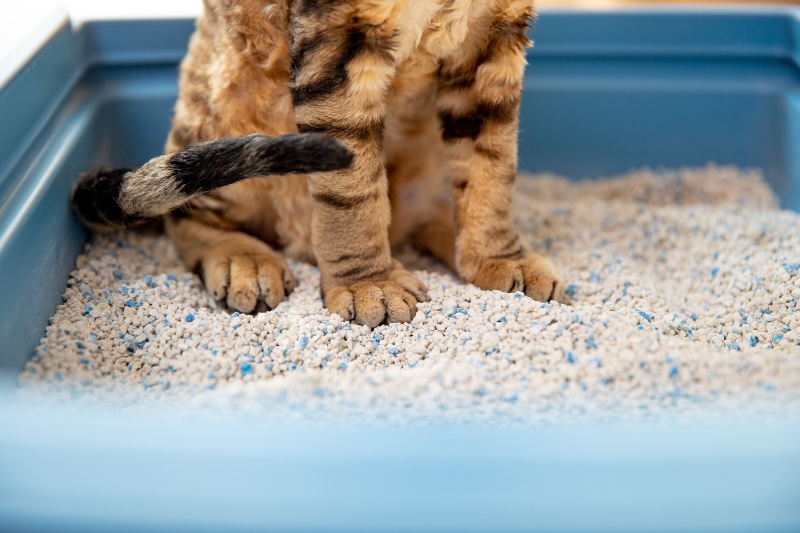
Effectively eliminating cat urine odours from your carpet is crucial for ensuring it is not a recurring issue.
As mentioned earlier, cats have a strong sense of smell. If they can detect urine on your carpet, they mistake it for a place they can do their business again and again. Rather than going to their litter tray, they’ll keep peeing in the same spot.
Thankfully, using our above cleaning methods should permanently remove any lingering cat urine odours from your carpet to stop your cat from urinating there again.
You should also consider the following tips, which can help prevent cat pee accidents in the future:
- Keep the litter box clean: You wouldn’t want to do your business in a dirty bathroom, and neither does your cat! Always maintain a clean litter box by scooping litter clumps and poop daily and cleaning the litter box completely once per week. If you have several cats, consider getting several litter boxes to prevent them from getting dirty too quickly.
- Check the litter box’s location: Your cat needs to reach its litter box easily. Ensure it is in an easily accessible room and on the same level your cat spends most of its time on. You should also keep the litter box away from high footfall areas or noisy appliances, as these can deter your cat from using it.
- Speak to your vet: If your cat keeps having bathroom accidents, it might be time to go to the vet. Your vet can address any underlying medical issues contributing to inappropriate urination, such as urinary infections, kidney disease, bladder problems, or diabetes. Old age and arthritis might also be a cause of incontinence.
- Create a calming environment: One of the main reasons cats pee outside the litter box is because of stress—they urinate as a form of territorial marking to help ease their anxiety. Use pheromone sprays or diffusers to create a calming environment for your cat and eliminate avoidable stressors.
- Cover your carpet: If all else fails, consider covering the carpeted areas with washable mats or rugs temporarily. This is not a permanent solution by any means, but it can help to prevent the nasty pee smells from getting worse and seeping into the deeper layers of your flooring while your kitty re-learns to use its litter tray.

Hannah has a passion for cleaning. She worked her way around Australia by cleaning hostels in exchange for free accommodation and used her cleaning skills to bag a job as a chalet host for a luxury ski company in France.
